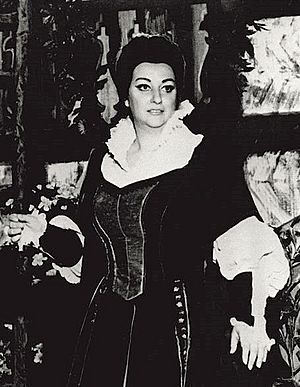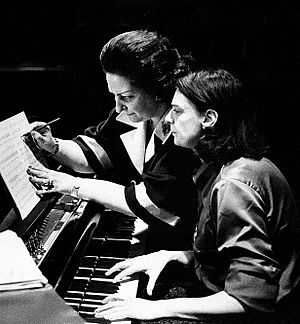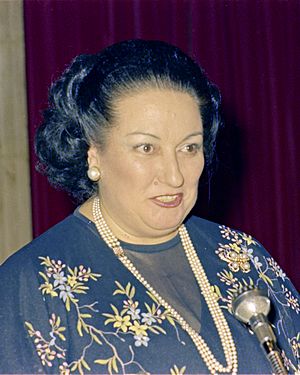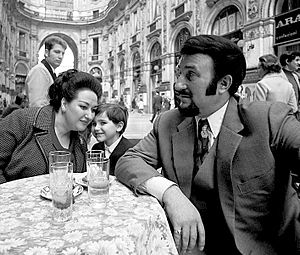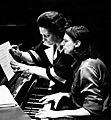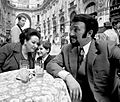Montserrat Caballé facts for kids
Quick facts for kids
Montserrat Caballé
|
|
|---|---|
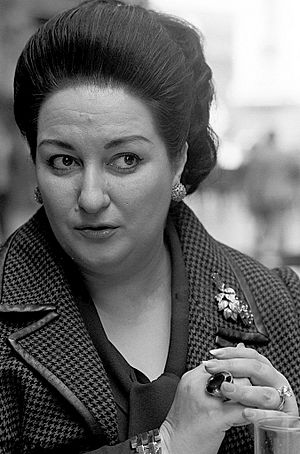
Caballé in Milan, 1971
|
|
| Born |
María de Montserrat Bibiana Concepción Caballé i Folch
12 April 1933 |
| Died | 6 October 2018 (aged 85) Barcelona, Spain
|
| Burial place | Cementiri de Sant Andreu, Barcelona |
| Other names | La Superba (The Superb One) |
| Education | Conservatori Superior de Música del Liceu |
| Occupation | Operatic soprano |
| Years active | 1956–2018 |
| Spouse(s) | |
| Children | 2, including Montserrat Martí |
| Awards |
|
Montserrat Caballé (born María de Montserrat Bibiana Concepción Caballé i Folch, 12 April 1933 – 6 October 2018) was a famous Spanish opera singer from Catalonia. Many people think she was one of the best sopranos of the 20th century. She won many music awards during her long career, including three Grammy Awards.
She sang many different types of roles in operas. She was especially known for singing music by Verdi and for her "bel canto" style. Bel canto means "beautiful singing" and focuses on smooth, flowing melodies and showing off the singer's voice. She was amazing at singing works by composers like Rossini, Bellini, and Donizetti.
Caballé became famous around the world in 1965. This happened when she stepped in to sing in Donizetti's Lucrezia Borgia at Carnegie Hall in New York. Her voice was described as pure and powerful. She was also known for her amazing control, especially when singing very softly.
She is also well-known for her 1987 song "Barcelona" with Freddie Mercury, the lead singer of the band Queen. They recorded this song for the 1992 Olympic Games in Barcelona. They both admired each other's talent and became good friends.
Contents
Montserrat Caballé's Early Life
Caballé was born in Barcelona, Spain, on 12 April 1933. Her family did not have much money because of the Spanish Civil War. She studied music at the Liceu Conservatory. She learned how to sing from teachers like Napoleone Annovazzi and Eugenia Kemény. She finished her studies with a gold medal in 1954.
After graduating, she moved to Basel, Switzerland. In 1956, she made her first professional appearance there. She filled in at the last minute to sing the role of Mimì in Puccini's La bohème. She then joined the Basel Opera company from 1957 to 1959. She sang roles in German, which was unusual for Spanish singers. This helped her when she later worked at the Bremen Opera from 1959 to 1962.
In 1962, Caballé returned to Barcelona. She performed for the first time at the Liceu opera house. She sang the main role in Strauss's Arabella. She also toured Mexico, singing in Massenet's Manon. She had many more successful shows at the Liceu in 1963.
Becoming a World-Famous Singer
Montserrat Caballé became famous worldwide in 1965. She took the place of another singer, Marilyn Horne, in a show of Donizetti's Lucrezia Borgia at Carnegie Hall in New York. She had to learn the role in less than a month! Her performance was so amazing that the audience gave her a 25-minute standing ovation. This made her a star in the opera world.
Later that year, Caballé sang at the Glyndebourne Festival. She performed her first Marschallin in Richard Strauss' Der Rosenkavalier. She also played Countess Almaviva in Mozart's Le nozze di Figaro.
In December 1965, she sang at Carnegie Hall again. She performed as Queen Elizabeth I in Donizetti's Roberto Devereux. Caballé also made her first appearance at the Metropolitan Opera in New York on 22 December 1965. She sang Marguerite in Gounod's Faust.
In the following years, Caballé continued to perform in major opera houses. She sang in Philadelphia, Italy, and returned to the Met many times. She performed famous roles like Leonora in Verdi's Il trovatore, Desdemona in Otello, and Violetta in La traviata. She also sang Liù in Puccini's Turandot with the famous singer Birgit Nilsson.
In 1970, Caballé officially debuted at La Scala in Italy, singing the title role in Lucrezia Borgia. She also sang in Verdi's Un ballo in maschera at the Met, which critics loved. In 1972, she performed at Covent Garden in London and the Lyric Opera of Chicago. She sang the role of Violetta in both places.
She continued to sing many important roles. In 1974, she performed in Verdi's Aida and I vespri siciliani. She also sang Norma at the Bolshoi Theatre in Moscow. In 1977, Caballé sang for the first time with the San Francisco Opera. She performed the main role in Puccini's Turandot. She returned to San Francisco many times, singing roles like Elvira in Verdi's Ernani and the title roles in Ponchielli's La Gioconda and Puccini's Tosca.
As she got older, her voice changed a bit, becoming more dramatic. She continued to perform often at the Met in the 1980s. Her last performances at the Met were in October 1985 as Tosca. People admired her voice for its purity, control, and power. She was known more for her amazing singing technique than for her acting.
Later Years and Special Projects
Montserrat Caballé recorded many operas and albums throughout her career. She recorded the main role in Bellini's Norma in 1972. Later, in 1984, she recorded the role of Adalgisa in the same opera. This was special because Adalgisa is usually sung by a mezzo-soprano, but Caballé, a soprano, sang it when she was over 50 years old.
In 1987, Caballé did something different. She sang a duet with Freddie Mercury, the lead singer of the rock band Queen. The song was called "Barcelona". It was inspired by her home city and became one of the official theme songs for the 1992 Summer Olympics. Freddie Mercury loved Caballé's voice and thought it was "the best in the world."
They released an album together the next year. The song "Barcelona" became the anthem for the 1992 Olympics and was very popular in Europe. Caballé even performed the song live, singing along with a recording of Mercury (who had passed away in 1991), before a big football match in Barcelona in 1999.
In 1995, she worked with the composer Vangelis on his album El Greco. In 1997, she released an album called Friends For Life. This album featured her singing duets with many different artists, like Bruce Dickinson and Johnny Hallyday.
Caballé also cared about helping others. She was a UNESCO Goodwill Ambassador. This means she helped promote peace and understanding around the world. She also started a foundation to help children in need in Barcelona. In 2003, a documentary film about her life was made called Caballé: Beyond Music. It included interviews with many famous opera singers.
She continued to perform in operas in her later years. In 2002, she was Catherine of Aragon in Henri VIII. In 2004, she sang the main role in Massenet's Cléopâtre. Both of these were at the Liceu opera house. In 2007, she appeared in Donizetti's La fille du régiment in Vienna.
In 2013, Caballé visited the region of Nagorno-Karabakh. Because of this visit, she was declared persona non grata (an unwelcome person) in Azerbaijan.
Montserrat Caballé's Family
Montserrat Caballé married Spanish tenor Bernabé Martí on 14 August 1964. They were married at the Santa Maria de Montserrat Abbey. They had two children: a son named Bernabé Martí Jr. and a daughter named Montserrat Martí. Their daughter Montserrat also became an opera singer, just like her mother.
Health and Passing Away
In October 2012, while on tour in Russia, Montserrat Caballé had a stroke. She was quickly taken to a hospital in Barcelona.
In September 2018, she was admitted to the same hospital for a gallbladder problem. She passed away there on 6 October 2018, at the age of 85. The cause of her death was not publicly shared. King Felipe VI of Spain called Caballé "the best of the best." The Spanish prime minister, Pedro Sánchez, said she was a great ambassador for Spain. Montserrat Caballé was buried in the Cementiri de Sant Andreu in Barcelona.
Recordings and Awards
Caballé made many recordings during her long career. She recorded complete operas and also albums of songs. She recorded for famous music labels like RCA Victor Red Seal, EMI, Decca, and Philips. She has a huge collection of recordings of her main opera roles. These include Aida, Don Carlo, Così fan tutte, Turandot, and Salome. She also recorded many "bel canto" and Rossini roles.
She also recorded special albums, like a Puccini collection and a Strauss collection. She sang duets with other famous singers like Shirley Verrett. She was also the soprano soloist in Verdi's Requiem.
Music Awards
Montserrat Caballé won several important music awards throughout her career.
| Award | Year | Recipient(s) | Category | Result | Ref. |
|---|---|---|---|---|---|
| Grammy Awards | 1967 | Montserrat Caballé – Presenting Montserrat Caballe (Bellini and Donizetti arias) | Best Classical Vocal Soloist Performance (with or without orchestra) | Nominated | |
| Album of the Year - Classical | Nominated | ||||
| 1969 | Montserrat Caballé – Rossini: Rarities | Best Vocal Soloist Performance | Won | ||
| 1975 | Richard Mohr (producer); Georg Solti (conductor), Judith Blegen, Montserrat Caballé, Plácido Domingo, Sherrill Milnes, Ruggero Raimondi - Puccini: La bohème (London Philharmonic Orchestra) | Best Opera Recording | Won | ||
| 1976 | Erik Smith (producer); Colin Davis (conductor), Richard Van Allan, Janet Baker, Montserrat Caballé, Ileana Cotrubaș, Wladimiro Ganzarolli, Nicolai Gedda - Mozart: Così fan tutte (Royal Opera House Orchestra) | Best Opera Recording | Won | ||
| 1989 | Richard Bonynge, Montserrat Caballé, Luciano Pavarotti, Samuel Ramey & Joan Sutherland; Andrew Cornall, producer – Bellini: Norma (Welsh National Opera Chorus; Welsh National Opera Orchestra) | Best Opera Recording | Nominated | ||
| 2004 | Montserrat Caballé – Songs of the Spanish Renaissance, Vol. 1 | Best Classical Vocal Performance | Nominated | ||
| Latin Grammy Awards | 2007 | Montserrat Caballé, artist. Carlos Caballé, producer. Mauricio Tonelli, engineer. Josep Baiges & Marc Blanes, engineers/mixers – La Canción Romántica Española | Best Classical Album | Won | |
| Primetime Creative Arts Emmy Awards | 1986 | John Goberman, producer; Marc Bauman, coordinating producer; Isaac Stern, Itzhak Perlman and Montserrat Caballé, performers - New York Philharmonic Celebration with Isaac Stern | Outstanding Classical Program in the Performing Arts | Nominated | |
| RSH-Gold | 1996 | Montserrat Caballé – Barcelona | Classic LP of the Year | Won |
Honours and Special Recognition
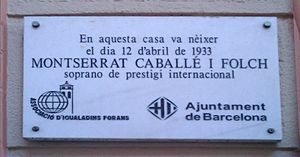
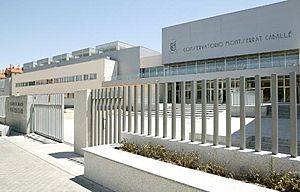
Montserrat Caballé received many honours and awards throughout her life, recognizing her incredible talent and contributions to music.
- 1966: Dame Commander of the Order of Isabella the Catholic
- 1975: Grand Cross of the Civil Order of Alfonso X, the Wise
- 1991: Prince of Asturias Award for the Arts. This is one of Spain's most important awards.
- 2003: Großes Bundesverdienstkreuz (Commander's Cross of the Order of Merit of the Federal Republic of Germany)
- 2005: Legion of Honour from France.
- 2007: Named Kammersängerin of the Vienna State Opera. This is a special title for outstanding opera singers.
- 2008: Received an honorary doctorate from the Universidad Internacional Menéndez Pelayo.
- 2009: Grand Cross of the Order of Merit of the Italian Republic.
- 2011: Received an honorary doctorate from the University of Barcelona.
- 2022: Featured in a Google Doodle on her 89th birthday, April 12.
Images for kids
See also
 In Spanish: Montserrat Caballé para niños
In Spanish: Montserrat Caballé para niños


